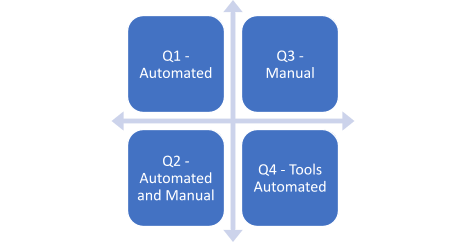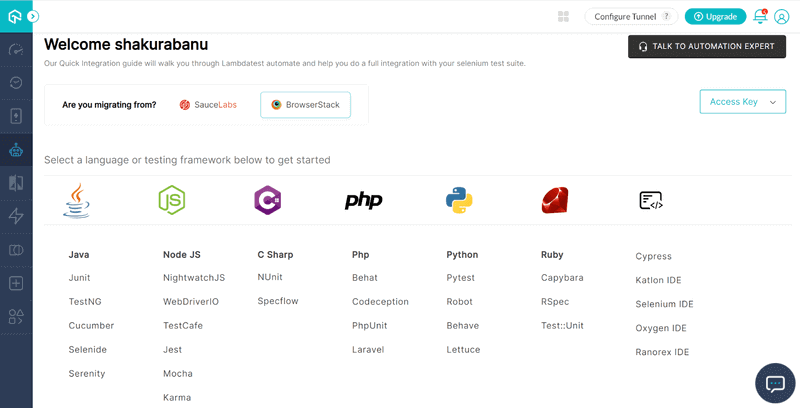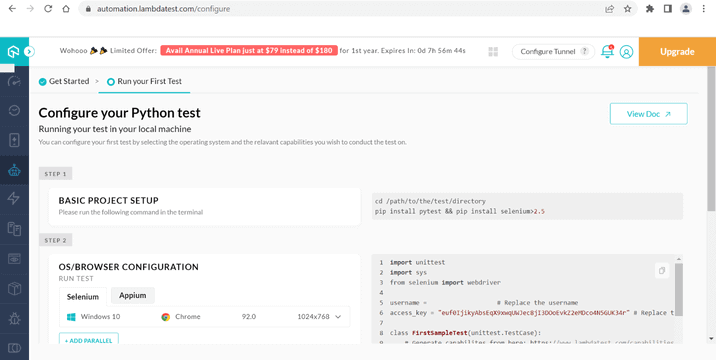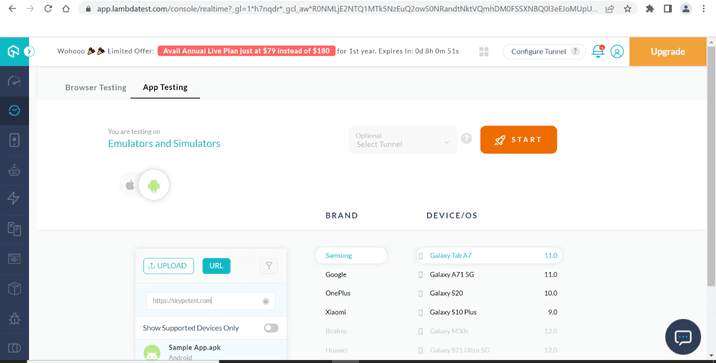What is Agile Testing: Importance, Process, and Life Cycle
- Learning Hub
- What is Agile Testing: Importance, Process, and Life Cycle
OVERVIEW
Agile testing is a software testing methodology aligned with the principles of agile software development. Agile development emphasizes collaboration, flexibility, and continuous iteration, and it is designed to support these principles by providing a flexible and adaptable approach to testing.
It focuses on early and continuous testing throughout the development process, emphasizing automated testing and collaboration between testers and developers. Agile testing aims to quickly identify and address defects to deliver high-quality software that meets the customer's needs.
History of Agile
The late 1970s saw a shift in technology with the introduction of personal computing. This meant that you had to meet customer requirements that were changing rapidly. You cannot rely on the traditional software development approach like Software Development Life Cycle (SDLC) for your software solutions and delivery.
By the early 1990s, a small group of software industry leaders had started developing and promoting new approaches that helped them to tackle changing requirements. In 2001, a small group of industry leaders met to introduce new and advanced methodologies. It was when the term Agile software development was first used. The set of values for using Agile, known as the Agile Manifesto, came into existence.
Agile Software Development
Agile Software Development is way beyond frameworks such as Scrum, Extreme Programming, or Feature Driven Development (FDD). It is an approach or mindset where you approach the software development process in a structured manner. It is driven by values and principles where you deliver iterative and high value to your customers.
One thing that separates Agile from other approaches we use in software development is the focus on individuals doing the work and how they work together to deliver significant value. The self-organizing cross-functional teams work in close collaboration, which is excellent from a customer delivery perspective.
Core values of Agile software development include:
- Focus on people rather than processes and tools. If the processes and tools drive development, then the team is less likely to be productive and less likely to respond to change. This means that you cannot meet key customer needs as well.
- A working piece of software is preferred over detailed documentation requirements. While Agile does not eliminate the use of documentation, it streamlines the way information is provided to the developers. This is where you have user stories that add significant value to the development teams.
- Ongoing collaboration with customers matters the most. Customers are involved throughout the development process through customer demos, user story mapping workshops, etc. They also interact with the teams daily to be well aware of the product progress.
- Be responsive to change rather than sticking to a fixed plan. It is all about working and delivering value in short iterations. The processes can be modified to best fit the software needs rather than relying on the traditional approach.
What is Agile Testing?
It is a testing practice that works on the rules and principles of Agile software development. Unlike the Waterfall method, Agile testing begins right at the beginning of the project, with development and testing happening simultaneously. It is a continuous approach where the development and testing teams collaborate closely to get things done. The objective of Agile development and testing is to achieve high product quality.
If you have been using the Waterfall model and planning to shift to Agile methodology, read through this tutorial on moving from Waterfall to Agile testing .
Key Agile Concepts
Agile Development is a set of principles and practices for delivering high-quality software in a rapid, incremental, flexible, and cost-effective manner. Agile values software development's "people" aspects, including individuals and interactions over processes and tools. It embraces change to meet customer needs with rapid adaptation to market conditions and technological advancements.
Here are some key concepts used in Agile and Agile testing:
- User Stories: It helps to divide the work into smaller increments known as user stories. Each user story adds value to the final product that is being developed.
- Daily Meeting: Each day, the entire team meets to discuss the daily progress on the assigned tasks.
- Team: A team in an Agile setup is a small group of people assigned to a module or feature.
- Incremental Development: Agile teams work on an incremental development approach where in each iteration, some predefined set of features or enhancements is added to improve customer value in the long run.
Agile Testing Vs Waterfall Testing
Below are the major differences between Agile and Waterfall testing:.
| Agile Testing | Waterfall Testing |
|---|---|
| It is an unstructured approach compared to waterfall testing, where you are not doing detailed planning. | The testing process is more structured, and a detailed analysis is done during the testing phase. |
| Since the testing begins at the start of the project, you can identify and fix issues when needed. This means you are well equipped to handle issues encountered during the project delivery. | The product is tested once the development is completed. For any issues, you need to go back and fix those issues. So, a lot of time is invested in performing testing and validation of those issues. |
| There is less documentation required. | The testing in the Waterfall approach requires detailed and elaborate documentation. |
| The features are shipped to the customer at the end of every iteration. | The features developed are delivered in one go once the implementation phase is completed. |
| Testers and Developers work in collaboration. | There is not much collaboration between developers and testers. |
| User acceptance is performed at the end of every sprint. | User acceptance can only be performed at the end of the project. |
| The testing team needs to be proactive and establish good communication with developers so that requirements can be analyzed and planned accordingly. The testing team needs to provide exact testing estimates in each sprint. | Testers can provide effort estimates once the development is over. |
Advantages of Agile Testing
Because Agile projects are often used with early release and often release methodologies, the need for an efficient testing process is crucial. In traditional projects, the testing process is often overlooked. Agile's focus on quality allows the team to identify defects early on while they are still easy to fix.
Early detection means that the developers can fix issues before they become costly and time-consuming issues. With a traditional approach, it might be too late when the customer discovers a defect because the defect might have been released to production.
Further advantages of Agile testing include:
- The tasks are divided into small iterations, so the project delivery is done within stipulated timelines.
- It is highly flexible and highly adaptable to changing project requirements
- You can identify blockers or issues through daily meetings and interactions
- The teams are well organized and self-motivated to get the required tasks done on time
- You can save a significant amount of time and effort with proper planning and execution
- It provides a great way for receiving regular feedback from the end user.
- The customers are involved during the entire course of the sprint, which means that they are well aware of the product requirements that are being developed.
Disadvantages of Agile Testing
Here are some of the shortcomings you must be aware of:
- Agile testing is all about being flexible and accommodating changes, but the changes are not always predicted. It becomes challenging for the users about what new features or enhancements will be introduced in the next iterations.
- Effort estimation can be difficult because there is a continuous change in requirements.
- Emphasis on documentation is lesser due to short sprints.
- Repetitive release of the software can result in higher expenses.
- Project delivery can be impacted if the resources are unavailable during each sprint or iteration.
Agile Test Plan
The kind of tests performed in each iteration is included in the Agile test plan. This consists of the test data needs, architecture, test environments, and different test results. The test plan is updated in every sprint. The Agile test plan contains the following aspects:
- Scope of testing
- New features and functionalities which are required to be tested
- Types of testing based on the complexity
- performance testing
- Risks and Mitigation Plan
- Resource Allocation
- Key Milestones
Agile Testing Life cycle
Agile testing life cycle contains five main phases:
- Phase 1: Impact Assessment
- Phase 2: Agile Test Planning
- Phase 3: Release Readiness
- Phase 4: Daily Scrums
- Phase 5: Test Agility Review

Let us discuss each of these phases in detail:
Phase 1: Impact Assessment
The first phase of the Agile testing life cycle is Impact Assessment. The required inputs and feedback are collected from users and required stakeholders to execute the impact assessment phase. This allows the testing team to decide on the expectations and needs for the next life cycle.
Phase 2: Agile Testing Plan
The second phase of Agile testing is Agile test planning. In this phase, all the required stakeholders such as developers, testers, business analysts, end-users, and even customers meet and finalize the testing process strategies, schedules, and deliverables.
Phase 3: Release Readiness
The third phase of Agile testing is Release Readiness, where the validation of features and enhancements are done by the testing team. The test engineers review and test the features to make sure that they are good enough to go live or not. Some of the features that are not built right need to be sent back to the development team.
Phase 4: Daily Scrums
The fourth phase of Agile testing is Daily Scrums. This is the daily status update meeting that helps to track the testing activities daily. It also allows an opportunity to discuss potential issues or blockers impacting product delivery. You can raise your problems or concerns repeatedly to provide a quick resolution.
Phase 5: Test Agility Review
The final phase of Agile testing is the Test Agility Review. It is about reviewing the key goals and milestones from a development perspective. It is all about reviewing some key aspects to ensure the project's progress is on the right track.
Agile Testing Principles
The Agile testing process is driven by some key principles:
- Continuous Testing: The testing is continuous and iterative. The Agile team performs continuous testing as it is the only way to ensure continuous progress and delivery of the product.
- Continuous Feedback Cycle: It is all about continuous and iterative feedback from relevant stakeholders so that the product meets the required quality and business needs.
- Testing is the Responsibility of the Entire Team: Gone are those days of the traditional software development life cycle where the testing team was involved in the end-to-end testing of the product or feature. In Agile testing, we have the developers as well as Business Analysts that are involved in testing the required product as well.
- Clean and Simplified Code: The code quality improves when all the defects raised by the Agile teams are fixed in the same iteration, which means that your code is clean and simplified.
- Test-Driven Approach: The testing is performed at the time of implementation, giving it equal importance along with development activities.
Methods of Agile Testing
The following methods are supported in Agile testing:
- Exploratory Testing In exploratory testing, test design and execution are done simultaneously. The tester is provided with the flexibility to break the system by using different user behaviors and patterns. No documentation is provided to the testing team, and the focus is on high-risk scenarios to be tested out.
- Risk-Based Testing: Under this method, the testing tasks are given priority based on the risks. This means that the areas that are critical and prone to greater risks are tested and verified first. Any issues or blockers in such areas can impact product delivery and quality. The less critical or smaller impact ones are validated at the last so that potential issues can be rectified easily.
- FIT Tests: FIT means Framework Integrated Test. As the name suggests, this method allows you to integrate tasks of developers, testers, and even customers. The result of testing in this method can be depicted in three different colors:
- Red
- Yellow
- Green
- Behavior-Driven Testing (BDD): In this method, testing is performed based on a system’s behavior or functionality. The Business Analysts and testers understand each other’s roles and responsibilities before the development starts and design requirements are finalized. Test scenarios are created, and the documentation of these scenarios can help to make informed testing decisions that help build the system's functionality.
- Acceptance Test-Driven Development (ATDD): These tests work based on customer feedback and inputs on how the software should perform. The acceptance tests showcase the behavior of the users so that the software meets their requirements in the long run.
Agile Testing Quadrants
There are so many types of tests, such as acceptance testing, regression testing, unit testing, and more. There are also scenarios where we need to decide whether manual or automated testing is better suited for the existing project or not. Gregory and Crispin introduced the concept of Agile testing Quadrants, which help you to decide the tests that need to be performed.
It is divided into four main quadrants:
- Q1
- Q2
- Q3
- Q4

Q1 - The Automated quadrant contains tests that are designed to improve the code quality of the product and helps the team to create better outcomes.
Q2 - The Automated and Manual quadrant contains tests that help to improve the business outcomes related to your product.
Q3 - The Manual quadrant contains tests with timely feedback for tests in quadrants 1 and 2. The required business outcomes can be achieved using comprehensive testing of the product.
Q4 - The Tools quadrant contains tests to ensure that technology can help the code fulfill required non-functional requirements such as security, scalability, etc.
Key Skills for Agile Tester
- Diverse technical knowledge related to Agile and its related concepts.
- Familiarity with different testing tools and automation frameworks.
- Ability to collaborate with different stakeholders.
- Willingness to work in a challenging environment.
- Passion for delivering value in business.
- Bringing testing improvements in the long run.
- Self-motivated and learning attitude.
How to do Agile Testing?
It is important to understand how teams can perform Agile testing so that they can derive maximum business value. Some of the key aspects include:
- Creating and updating a test plan for each release or iteration.
- During the planning phase, testing resources are identified, testing tools are set up, and the entire testing strategy is finalized so that the entire team is well aware of the processes that are being followed.
- The Agile testing is done along with the development activities. The testing team can collaborate with developers to be well aware of the functionality changes and testing scope.
- The functionality is deployed in the production environment, users are trained, and acceptance testing is performed.
- The testing team makes sure that required features can be tested if there are improvements in the long run.
Having the right strategy in place for Agile testing within your teams is important. The testing team should be well aware of the testing scope and schedule so that they can plan their testing accordingly. When done right, Agile testing can greatly impact the overall end-user experience.
All You Need to Know About LambdaTest Platform – Simplifying Agile Testing
Agile testing has become an integral part of the application lifecycle and gained widespread acceptance for delivering high-quality products. This means that the different teams must work in close collaboration to achieve desired outcomes. This is where you need the expertise of a unified cross browser testing platform to make sure that the Agile testing requirements are implemented in real quick time.
Cross browser testing ensures that your web application works seamlessly across different supported browsers without impacting the overall quality. This is why LambdaTest has transformed the entire testing ecosystem with a unique set of features and enhancements.
You can perform manual and automated testing using this platform by utilizing the cloud infrastructure.
Here are some of the great features that make the LambdaTest a preferred choice for businesses worldwide:
- You can easily analyze the visual elements of the web application.
- You can test responsiveness of different screen sizes without compromising the quality of the website’s appearance.
- Run Mobile app test on real device cloud and Mobile emulator online.
- You can locally host web application testing so that your application or website can achieve the desired performance.
- Geolocation testing to test from different locations.
You can integrate the LambdaTest platform with your favorite tool, such as Bitbucket, Slack, GitHub, JIRA, etc. so that you can track the status of your project effectively.
Benefits of LambdaTest Platform for End-Users
- All the end users get 24*7 continuous support from an expert team of technical professionals. If you do not wish to contact the team via email, live chat, or phone calls, a support ticket can also be raised.
- The end users get timely notifications related to different system tasks so that they can view the status updates in real-time.
- The end users can view dashboards based on the different data trends.
Let us try and understand the different testing approaches implemented using the LambdaTest platform:
- Live Testing: This can be performed for websites and applications on different mobile and desktop browsers.
- Online Selenium Test Automation: This is another great feature offered by the LambdaTest platform where you can run your Selenium test automation scripts across the online Selenium grid of desktop, Android, and iOS mobile browsers.
Subscribe to the LambdaTest YouTube channel and stay updated with the latest tutorials around Selenium testing, Cypress testing, CI/CD, and more.
- Automation Testing: You can enable Agile software testing with Automation. Automation testing is all about improving the system performance by automating repetitive tasks. This is where you can choose the Automation feature from the LambdaTest platform for testing your web and mobile applications. LambdaTest provides you the functionality to manage your automated builds so that you can check the progress in real-time.
Follow these steps if your team has no automation requirements in place:
- Identify the skill set of the entire team.
- Identify the gaps in your existing testing strategies.
- Implement and execute automation requirements slowly.
You can click on the Automation tab on the left navigation panel, which provides the following options:
- Builds
- Test Archive
- Analytics
You can also migrate your test suites or scripts on LambdaTest from other cloud-testing platforms to get started. If not, you can select a language or testing framework from the available options in UI.

If we select Python as the language, you must configure the project setup and OS/Browser configuration using the following screen. You can execute your test case by configuring the required details.
For Agile teams, it is important to have some form of automated testing in place. Without it, testing can be challenging and impact how you deliver high-value features. So, make this decision by involving all the required stakeholders.

LambdaTest gives you the flexibility to perform comprehensive testing using different brands and devices for your web and mobile applications:
LambdaTest gives you the flexibility to perform comprehensive testing using different brands and devices for your web and mobile applications:
The following two options are available under App Testing:
- iOS
- Android
You can choose either of the two options based on your testing requirements:
Follow these steps to perform app testing:
- Select the required application platform.
- Enter the app source URL or upload a zip folder based on the data requirements
- Select the device type from the available options.
- Select the required device.
- Select the operating system.
- Once all the required details are entered, click Start.

Agile Testing Best Practices
Agile testing can be challenging if not performed considering some of the Agile testing best practices.
Agile development is not just about programming, it extends to all aspects of the software life cycle. As a result, Agile testing best practices vary from other testing methods in some fundamental ways.
Each phase has its purpose and time frame, and it is up to the organization to decide which activities fall within which phase. A new Agile tester needs to be aware of these phases and activities and knows how they impact the overall testing process.
Follow the following best practices to avoid Agile testing challenges:
- Maintaining code austerity
- Repetitive Tests
- Communication with Developers
- One Functionality at a Time
Agile software development relies on many principles and techniques to produce high-quality software. One of the most important is code austerity, which means keeping your code clean and simple by pruning away unnecessary elements.
As you create your test cases, you'll inevitably find that some tests must be repeated for each new feature or bug fix. The same test case might need to be run for every build type, branch, and environment. A test case with many variations is a sign of bad design.
Agile has made testing more critical than ever. With frequent deployments, ensuring that your software is always in a deployable state and working as expected is important. This requires well-tested and maintained code. To achieve this, Agile teams must make sure they have clear communication between their testers and developers.
Communication is essential in Agile because the team constantly adjusts its sprint priorities based on changing requirements. Both testers and developers must be able to adapt to these changes quickly, so they must always be in sync about what each team member is working on at any given time.
When you test one functionality at a time, it is easier to figure out what went wrong and why something did not go according to your expectations. If you have already tested a certain functionality, then you know that this particular feature works fine, and there is no need to spend time on it again.
Wrap Up!
We discussed different aspects related to Agile testing in this blog. Agile testing is an iterative and incremental testing approach that helps to add great business value to customers. It is a smarter approach than other traditional testing procedures where you are well equipped to handle changes in requirements or scope. LambdaTest platform simplifies the way organizations approach Agile testing.
LambdaTest comes with flexible pricing options that you can choose based on your requirements. You are required to do free signup, and then you can explore the different sets of features. Customer experience has been the topmost aspect of the LambdaTest platform, which is why you will see more and more features that will solve complex customer problems or pain points.
Frequently Asked Questions (FAQs)
What is Agile testing in QA?
A software approach called agile QA testing aims to incorporate the ideas of agile software development into the QA testing process. Agile testing emphasizes the iterative nature of agile and CI/CD development cycles and tries to match QA with the release cadence.
What are the challenges in Agile testing?
Changing requirements, Inadequate information, Continuous testing, Technical expertise, Frequent regression cycles, Lack of communication, Lack of quality measurement
What are the four stages of Agile testing strategies?
Agile teams are being helped to identify where to concentrate testing efforts in each step of the product life cycle, including sprint zero, construction iterations, deployment, and production.
Reviewer's Profile

Shahzeb Hoda
Shahzeb currently holds the position of Senior Product Marketing Manager at LambdaTest and brings a wealth of experience spanning over a decade in Quality Engineering, Security, and E-Learning domains. Over the course of his 3-year tenure at LambdaTest, he actively contributes to the review process of blogs, learning hubs, and product updates. With a Master's degree (M.Tech) in Computer Science and a seasoned expert in the technology domain, he possesses extensive knowledge spanning diverse areas of web development and software testing, including automation testing, DevOps, continuous testing, and beyond.
 Christmas Deal is on: Save 25% off on select annual plans for 1st year.
Christmas Deal is on: Save 25% off on select annual plans for 1st year.


